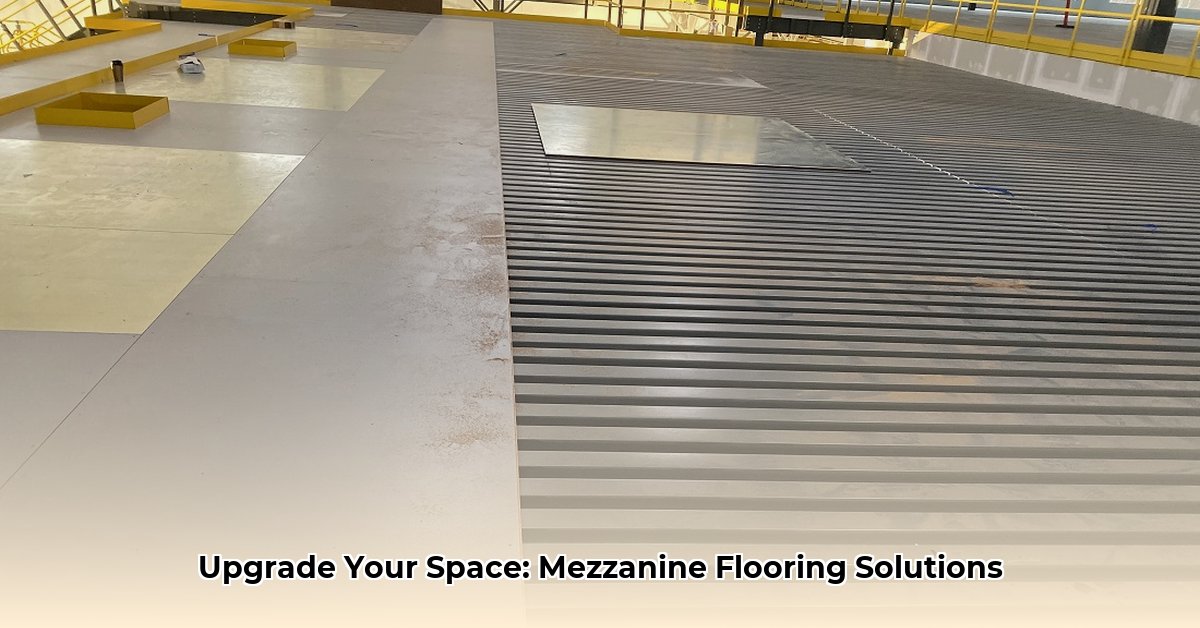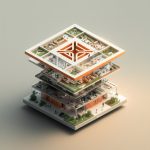Selecting the right flooring for your warehouse mezzanine is a critical decision that impacts safety, efficiency, and your bottom line. This comprehensive guide will walk you through everything you need to know to make an informed choice for your business. We’ll compare various flooring types, from ResinDek to bar grating, guide you in determining your specific needs, offer advice on finding a reliable installer, and provide tips for maintaining your floors for long-term performance. Learn more about mezzanine floors to get started. Let’s dive in and discover the ideal flooring solution for your warehouse!
Industrial Mezzanine Flooring Options: A Detailed Guide
Choosing the correct flooring for your industrial mezzanine is paramount. It directly affects the safety of your employees, the efficiency of your operations, and ultimately, your profitability. This guide provides a detailed walkthrough of the selection process, ensuring you approach the decision with confidence and clarity. We will explore high-performance warehouse flooring solutions to optimize your workspace.
Key Factors for Selecting Mezzanine Floors: Making an Informed Decision
Several critical factors influence the suitability of a mezzanine floor for your specific needs. Let’s examine these elements in detail:
-
Load-Bearing Capacity: The anticipated weight load is a primary consideration. Accurately assess the maximum weight your mezzanine will need to support, including machinery, stored materials, and personnel. Exceeding the floor’s rated capacity can lead to structural failure and pose serious safety risks. Opting for a higher weight capacity than initially anticipated can provide a safety margin for future needs. Flooring options like ResinDek are engineered for substantial loads and robotic applications.
-
Fire Resistance and Safety Compliance: Compliance with fire safety regulations is non-negotiable. Building codes mandate specific fire-resistance ratings for mezzanine flooring, depending on the intended use and occupancy. Steel and concrete inherently offer excellent fire resistance. Other materials, such as ResinDek or bar grating, may require the application of fire-retardant coatings or integration with fire suppression systems to meet code requirements. Conduct thorough research on local and national building codes.
-
Maintenance Requirements and Lifecycle Costs: Evaluate the ongoing maintenance demands associated with different flooring options. Concrete, while exceptionally durable, can be challenging and costly to repair if damaged. Bar grating may require periodic cleaning to prevent the accumulation of debris, potentially affecting ventilation and light penetration. Consider the availability and cost of replacement parts or specialized cleaning services. Low-maintenance options may have a higher initial cost but offer long-term savings. Consider the durable mezzanine flooring materials that offer lasting value.
-
Budgetary Constraints and Return on Investment: Establish a realistic budget that encompasses material costs, installation expenses, and anticipated maintenance expenditures. While cost is a significant factor, prioritize long-term value and performance over initial affordability. Investing in a durable, high-quality flooring system can reduce the likelihood of premature replacement or extensive repairs, resulting in a greater return on investment over the mezzanine’s lifespan. Explore the cost-effective mezzanine flooring options that align with your budget.
Common Flooring Types for Industrial Spaces: An In-Depth Analysis
Let’s explore the characteristics, advantages, and disadvantages of the most prevalent flooring options for industrial mezzanines:
-
ResinDek: ResinDek is a high-density composite panel engineered for demanding industrial applications. Renowned for its exceptional durability and resistance to impact, abrasion, and moisture, ResinDek is ideally suited for high-traffic areas, automated guided vehicles (AGVs), and robotic operations. While offering superior performance, ResinDek typically commands a higher upfront cost compared to other flooring materials. Understand how industrial mezzanine flooring benefits can enhance your operational efficiency.
-
Bar Grating: Bar grating is a cost-effective and versatile flooring solution characterized by its open grid design. This design facilitates airflow, natural light penetration, and sprinkler system effectiveness, making it suitable for environments with fire safety concerns. Bar grating’s load-bearing capacity is generally lower than solid flooring options, limiting its use in heavy-duty applications. Carefully consider safety implications.
-
Steel Decking: Steel decking offers a compelling blend of strength, fire resistance, and affordability. Typically constructed from corrugated steel sheets, steel decking provides a robust and stable platform for a variety of industrial uses. Steel decking can be customized with various finishes, such as galvanized coatings or powder coatings, to enhance corrosion resistance and aesthetics. Explore the mezzanine flooring for heavy loads that steel decking provides.
-
Concrete: Concrete represents the pinnacle of durability and fire resistance in mezzanine flooring. Capable of withstanding extremely heavy loads and providing exceptional structural stability, concrete is often specified for applications where longevity and minimal maintenance are paramount. However, concrete floors are relatively inflexible, requiring specialized equipment and expertise for installation or modification. Delve into fire-resistant flooring solutions for enhanced safety.
A Step-by-Step Guide to Selecting the Ideal Floor
Follow this structured approach to make a well-informed decision regarding your mezzanine flooring:
Step 1: Thorough Needs Assessment. Before exploring specific products, conduct a comprehensive assessment of your operational requirements. Determine:
- Maximum anticipated load requirements, accounting for both static and dynamic loads.
- Applicable fire safety regulations and insurance requirements.
- Budgetary limitations and desired return on investment.
- Maintenance capabilities and preferred flooring lifespan.
- Aesthetic considerations and integration with existing facility design.
Step 2: Material Selection. Based on your needs assessment, identify candidate flooring materials that align with your performance criteria and budgetary constraints. Consider the long-term implications of your choice.
Step 3: Supplier Vetting and Quotation Acquisition. Solicit quotes from multiple reputable suppliers with demonstrated expertise in industrial mezzanine flooring. Evaluate suppliers based on product quality, installation capabilities, warranty provisions, and customer references. Do not solely focus on the lowest price, but rather on the overall value proposition.
Step 4: Professional Installation. Engage qualified and experienced professionals to handle the installation of your mezzanine flooring. Proper installation is crucial for ensuring structural integrity, safety compliance, and long-term performance. Verify that the installation crew possesses the necessary certifications and adheres to industry best practices. Understand the significance of professional mezzanine flooring installation.
Maintaining Your Mezzanine Floor for Longevity
Implementing a proactive maintenance program is essential for maximizing the lifespan and performance of your mezzanine flooring. Regular inspections, prompt repairs, and appropriate cleaning procedures can prevent premature deterioration and costly replacements. Develop a maintenance schedule tailored to the specific characteristics of your chosen flooring material and the intensity of your operational environment. Discover the long-term cost savings for warehouse flooring through proper maintenance.
Visual Comparison of Flooring Options
| Flooring Type | Fire Resistance | Load Capacity | Maintenance | Cost | Key Advantages | Potential Drawbacks |
|---|---|---|---|---|---|---|
| ResinDek | Moderate | High | Low | Higher | Exceptional durability, impact resistance, robotic apps | Higher initial cost, may require specialized installation |
| Bar Grating | Low | Moderate | Low | Lower | Cost-effective, excellent airflow/light penetration | Lower load capacity, potential safety concerns with small items |
| Steel Decking | High | High | Moderate | Moderate | Strong, fire-resistant, versatile applications | Requires periodic cleaning and inspection |
| Concrete | High | Highest | Low | Highest | Extremely durable, fireproof, minimal maintenance | High upfront cost, limited design flexibility, difficult to modify |
Ultimately, the ideal mezzanine flooring solution is contingent upon your unique operational requirements, budgetary considerations, and long-term performance expectations. Thorough planning, diligent research, and expert guidance are essential for making an informed decision that optimizes the value and functionality of your industrial space. Consult with structural engineers to get specific input for you weight and building requirements.
- Glass Mosaic Backsplash: A Stylish Upgrade For Your Kitchen - December 8, 2025
- Glass Tile Shower Ideas to Create a Stunning Bathroom Space - December 7, 2025
- Glass Wall Tile Ideas for Kitchens and Bathrooms - December 6, 2025










